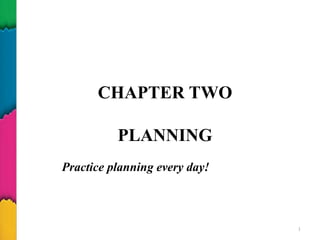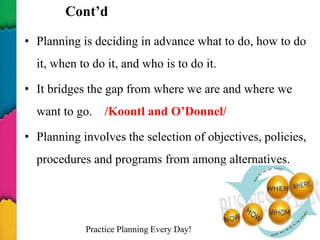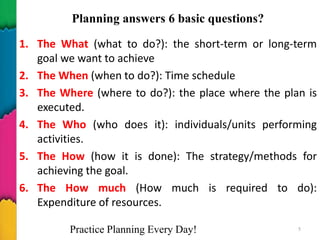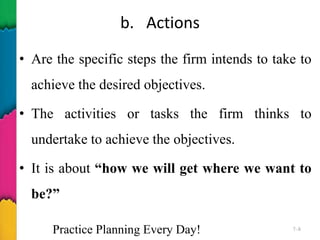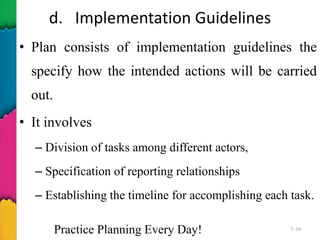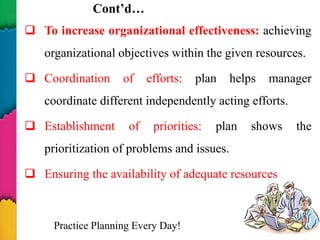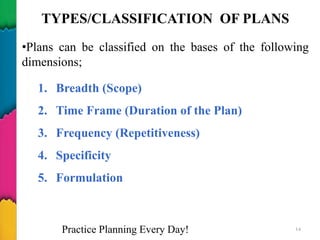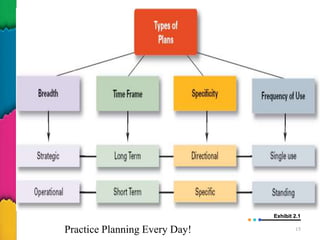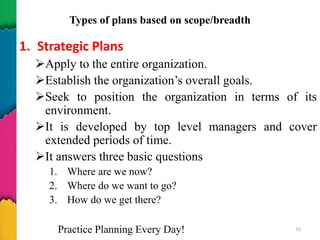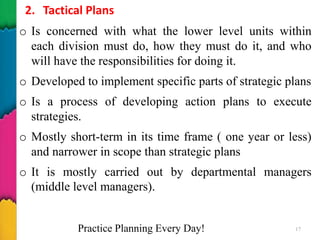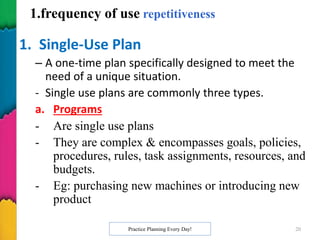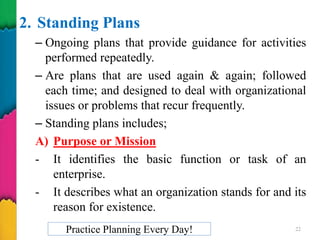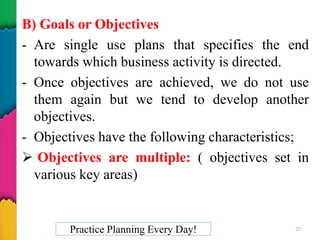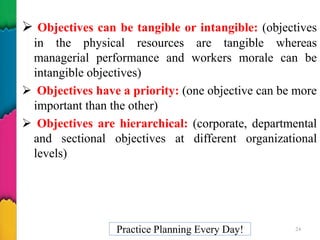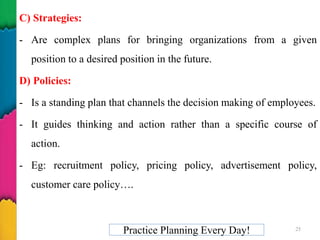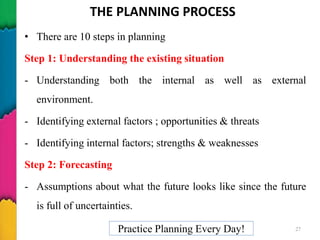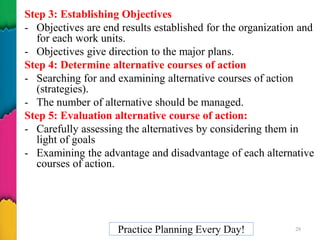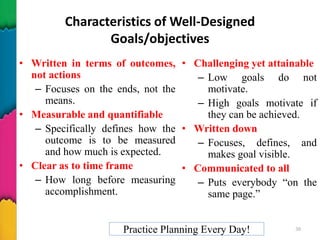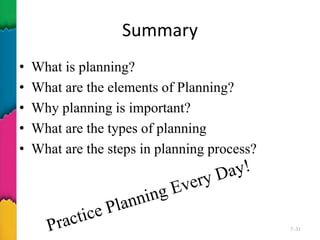MA CH 2 presentation for students All.ppt
- 1. CHAPTER TWO PLANNING 1 Practice planning every day!
- 2. Practice Planning Every Day! 2 ’āś To introduce the concept and definition of planning. ’āś Analyze the nature and importance of planning. ’āś Discuss various types of planning. ’āś Explain steps in planning. Learning Objectives
- 3. What Is Planning? ŌĆó Planning ŌĆō A primary managerial activity that involves: ŌĆó Defining the organizationŌĆÖs goals and objectives ŌĆó Establishing an overall strategy for achieving those goals ŌĆó Developing a comprehensive set of plans to integrate and coordinate organizational work. ŌĆō Is a blueprint of future course of action ’üČInformal and formal planning ŌĆó Informal: not written down, short-term focus; specific to an organizational unit. ŌĆó Formal: written, specific, and long-term focus, involves shared goals for the organization. Practice Planning Every Day! 3
- 4. ContŌĆÖd ŌĆó Planning is deciding in advance what to do, how to do it, when to do it, and who is to do it. ŌĆó It bridges the gap from where we are and where we want to go. /Koontl and OŌĆÖDonnel/ ŌĆó Planning involves the selection of objectives, policies, procedures and programs from among alternatives. Practice Planning Every Day! 4
- 5. Planning answers 6 basic questions? 1. The What (what to do?): the short-term or long-term goal we want to achieve 2. The When (when to do?): Time schedule 3. The Where (where to do?): the place where the plan is executed. 4. The Who (who does it): individuals/units performing activities. 5. The How (how it is done): The strategy/methods for achieving the goal. 6. The How much (How much is required to do): Expenditure of resources. Practice Planning Every Day! 5
- 6. Key Elements of Planning ŌĆó Planning has four elements; a. Objectives b. Actions c. Resources d. Implementation Practice Planning Every Day! 7ŌĆō6
- 7. a. Objectives ŌĆó Objectives are goals or targets that the firm wishes to reach within a stated amount of time. ŌĆó Planning requires managers to anticipate/for.c/ what is likely to happen in the future. ŌĆó It is the future destination of the organization, which all employees directed by. ŌĆó The where will we want to be in the future! Practice Planning Every Day! 7ŌĆō7
- 8. b. Actions ŌĆó Are the specific steps the firm intends to take to achieve the desired objectives. ŌĆó The activities or tasks the firm thinks to undertake to achieve the objectives. ŌĆó It is about ŌĆ£how we will get where we want to be?ŌĆØ Practice Planning Every Day! 7ŌĆō8
- 9. c. Resource Allocation ŌĆó Plan identifies what resources are required, where they come from, and how they will be arranged. ŌĆó A manager should be aware of resource constraints and how it would be efficiently used. ŌĆó Decisions regarding resource allocation determine whether the goals can be realistically achieved. ŌĆó The ŌĆ£how much it costsŌĆØ Practice Planning Every Day! 7ŌĆō9
- 10. d. Implementation Guidelines ŌĆó Plan consists of implementation guidelines the specify how the intended actions will be carried out. ŌĆó It involves ŌĆō Division of tasks among different actors, ŌĆō Specification of reporting relationships ŌĆō Establishing the timeline for accomplishing each task. Practice Planning Every Day! 7ŌĆō10
- 11. IMPORTANCE OF PLANNING ŌĆó Planning is important for the following reasons ’ü▒ Primacy of Planning: first and foremost function of management ’ü▒ It reduces risk & uncertainty: planning helps to cope up with & prepare for changing envŌĆÖt. ’ü▒ To focus attention on objectives: planning focuses on organizational objectives and how to achieve these objectives. ’ü▒ Sets the standards for controlling : control can be exercised if there are plans (standards or goals) Practice Planning Every Day! 11
- 12. ContŌĆÖdŌĆ” ’ü▒ To increase organizational effectiveness: achieving organizational objectives within the given resources. ’ü▒ Coordination of efforts: plan helps manager coordinate different independently acting efforts. ’ü▒ Establishment of priorities: plan shows the prioritization of problems and issues. ’ü▒ Ensuring the availability of adequate resources Practice Planning Every Day! 12
- 13. Limitations of Planning ŌĆó Poor forecasts of future conditions ŌĆō Business environment is changing faster than ever. Even most sophisticated planning techniques may not expect accurately what is likely to happen in the future. ŌĆó Plans imposed from above ŌĆō Sometimes plan generator is different from plan implementer ŌĆō Plans that are not from the wisdom and experience of those at the operational levels within the firm. ŌĆó Planning as a self-contained activity ŌĆō Planning task may be given to separate units (planning staff) from the rest of the organization. ŌĆó Planning do not allow employees flexibility Practice Planning Every Day! 7ŌĆō13
- 14. TYPES/CLASSIFICATION OF PLANS Practice Planning Every Day! 14 ŌĆóPlans can be classified on the bases of the following dimensions; 1. Breadth (Scope) 2. Time Frame (Duration of the Plan) 3. Frequency (Repetitiveness) 4. Specificity 5. Formulation
- 15. Practice Planning Every Day! 15 Exhibit 2.1
- 16. Types of plans based on scope/breadth 1. Strategic Plans ’āśApply to the entire organization. ’āśEstablish the organizationŌĆÖs overall goals. ’āśSeek to position the organization in terms of its environment. ’āśIt is developed by top level managers and cover extended periods of time. ’āśIt answers three basic questions 1. Where are we now? 2. Where do we want to go? 3. How do we get there? Practice Planning Every Day! 16
- 17. 2. Tactical Plans o Is concerned with what the lower level units within each division must do, how they must do it, and who will have the responsibilities for doing it. o Developed to implement specific parts of strategic plans o Is a process of developing action plans to execute strategies. o Mostly short-term in its time frame ( one year or less) and narrower in scope than strategic plans o It is mostly carried out by departmental managers (middle level managers). Practice Planning Every Day! 17
- 18. 3. Operational Plans ŌĆó Also called administrative plans are those a manger uses to accomplish his/her job responsibilities ŌĆó It can be a single use plan like a program or standing plan like policy. ŌĆó Focuses on carrying out tactical plans to achieve operational goals. ŌĆó Mainly short range and more specific and detailed. ŌĆó Concerned with day to day; week to week activities of the organizations. ŌĆó These plans are developed by Supervisory level managers. Practice Planning Every Day! 18
- 19. 1. Long-range Plans ŌĆō Plans with time frames extending beyond three years (5-10 years) depending on the size & nature of the organization 2. Intermediate - range Plans ŌĆō Ranges b/n long & short range plans ŌĆō Plans with time frame of 1-3 years depending on the size & nature of the organization. 3. Short ŌĆō range Plans ŌĆō Are not developed separately ŌĆō Are operational plans derived from long-range or intermediate plans ŌĆō Plans with time frames of less than 1 year depending on the size & nature of the organization. Practice Planning Every Day! 19 Time frame
- 20. 1. Single-Use Plan ŌĆō A one-time plan specifically designed to meet the need of a unique situation. - Single use plans are commonly three types. a. Programs - Are single use plans - They are complex & encompasses goals, policies, procedures, rules, task assignments, resources, and budgets. - Eg: purchasing new machines or introducing new product Practice Planning Every Day! 20 1.frequency of use repetitiveness
- 21. 2) Projects - Are smaller portion of a program. - Are less comprehensive & narrower in focus than programs. - They have predetermined time schedule for completion. 3) Budgets - Is the resources required in numerical terms - It is a quantitative statement of the resources allotted to specific programs or projects for a given period. - It serves as a benchmark for controlling. Practice Planning Every Day! 21
- 22. 2. Standing Plans ŌĆō Ongoing plans that provide guidance for activities performed repeatedly. ŌĆō Are plans that are used again & again; followed each time; and designed to deal with organizational issues or problems that recur frequently. ŌĆō Standing plans includes; A) Purpose or Mission - It identifies the basic function or task of an enterprise. - It describes what an organization stands for and its reason for existence. Practice Planning Every Day! 22
- 23. B) Goals or Objectives - Are single use plans that specifies the end towards which business activity is directed. - Once objectives are achieved, we do not use them again but we tend to develop another objectives. - Objectives have the following characteristics; ’āś Objectives are multiple: ( objectives set in various key areas) Practice Planning Every Day! 23
- 24. ’āś Objectives can be tangible or intangible: (objectives in the physical resources are tangible whereas managerial performance and workers morale can be intangible objectives) ’āś Objectives have a priority: (one objective can be more important than the other) ’āś Objectives are hierarchical: (corporate, departmental and sectional objectives at different organizational levels) Practice Planning Every Day! 24
- 25. C) Strategies: - Are complex plans for bringing organizations from a given position to a desired position in the future. D) Policies: - Is a standing plan that channels the decision making of employees. - It guides thinking and action rather than a specific course of action. - Eg: recruitment policy, pricing policy, advertisement policy, customer care policyŌĆ”. Practice Planning Every Day! 25
- 26. 3. Contingency Planning - Involves identifying alternative courses of action that can be implemented if and when the original plan proves inadequate because of changing conditions. - Unexpected problems and events frequently occur. When they do, managers may need to change their plans. Anticipating change during the planning process is best in case things donŌĆÖt go as expected. - Contingency planning is necessary at each level of management and for strategic, tactical, and operational planning. Practice Planning Every Day! 26
- 27. THE PLANNING PROCESS ŌĆó There are 10 steps in planning Step 1: Understanding the existing situation - Understanding both the internal as well as external environment. - Identifying external factors ; opportunities & threats - Identifying internal factors; strengths & weaknesses Step 2: Forecasting - Assumptions about what the future looks like since the future is full of uncertainties. Practice Planning Every Day! 27
- 28. Step 3: Establishing Objectives - Objectives are end results established for the organization and for each work units. - Objectives give direction to the major plans. Step 4: Determine alternative courses of action - Searching for and examining alternative courses of action (strategies). - The number of alternative should be managed. Step 5: Evaluation alternative course of action: - Carefully assessing the alternatives by considering them in light of goals - Examining the advantage and disadvantage of each alternative courses of action. Practice Planning Every Day! 28
- 29. Step 6: Selecting a course of action - is the point at which the plan is approved. - It is the real point of decision making. Step 7: Formulating derivative plans - Derivative plans are those which support the main plan. Step 8: budgeting: ŌĆó At this point, all necessary resources are determined for each units, tasks and individuals. Step 9: Implementing the plans - Developing action plans to implement plans. Step 10: Controlling & evaluating the results - Evaluate reported results and make necessary adjustments Practice Planning Every Day! 29
- 30. Characteristics of Well-Designed Goals/objectives ŌĆó Written in terms of outcomes, not actions ŌĆō Focuses on the ends, not the means. ŌĆó Measurable and quantifiable ŌĆō Specifically defines how the outcome is to be measured and how much is expected. ŌĆó Clear as to time frame ŌĆō How long before measuring accomplishment. ŌĆó Challenging yet attainable ŌĆō Low goals do not motivate. ŌĆō High goals motivate if they can be achieved. ŌĆó Written down ŌĆō Focuses, defines, and makes goal visible. ŌĆó Communicated to all ŌĆō Puts everybody ŌĆ£on the same page.ŌĆØ Practice Planning Every Day! 30
- 31. Summary ŌĆó What is planning? ŌĆó What are the elements of Planning? ŌĆó Why planning is important? ŌĆó What are the types of planning ŌĆó What are the steps in planning process? 7ŌĆō31
- 32. Thank you for your attention!! 32
